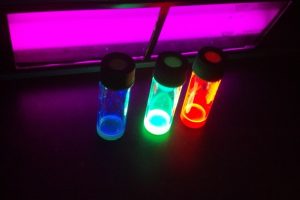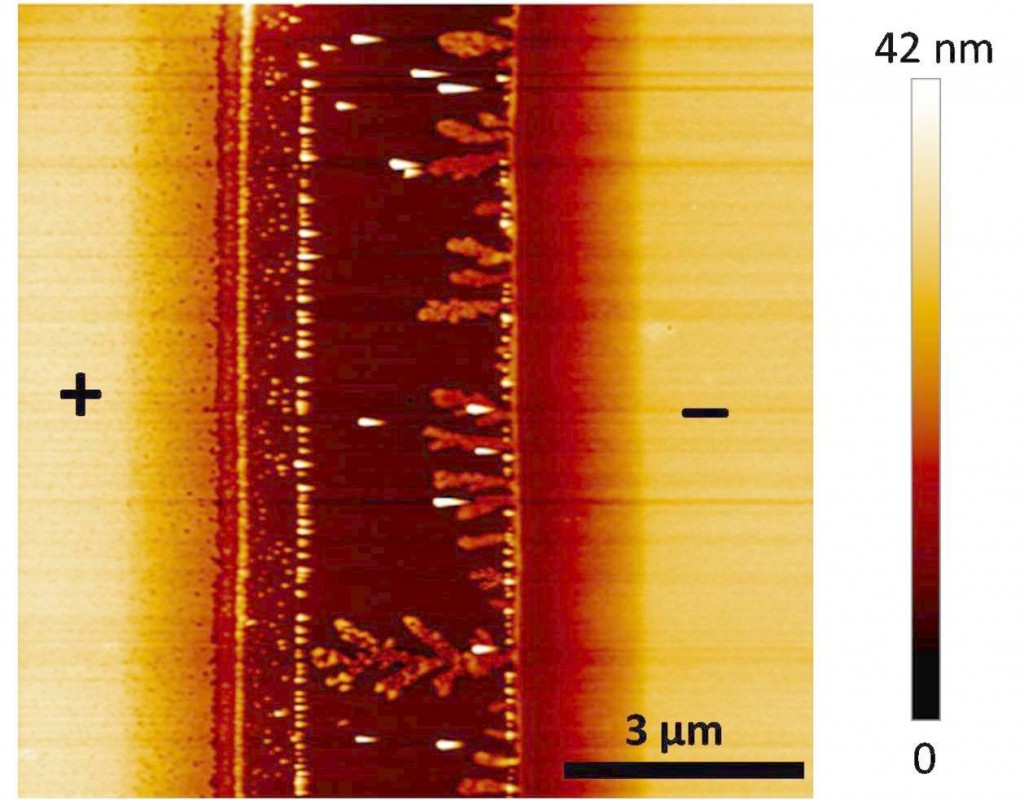Paper: Amine-Free Synthesis of Cesium Lead Halide Perovskite Quantum Dots for Efficient Light-Emitting Diodes. Emre Yassitepe, Zhenyu Yang, Oleksandr Voznyy, Younghoon Kim, Grant Walters, Juan Andres Castañeda, Pongsakorn Kanjanaboos, Mingjian Yuan, Xiwen Gong, Fengjia Fan, Jun Pan, Sjoerd Hoogland, Riccardo Comin, Osman M. Bakr, Lazaro A. Padilha, Ana F. Nogueira, and Edward H. Sargent. Adv. Funct. Mater. 2016. DOI: 10.1002/adfm.201604580.
How to make more stable perovskite nanocrystals for more efficient LEDs.

Perovskite quantum dots have been seen as great candidates to compose a next generation of displays and lighting devices. In fact, these luminescent nanoparticles are able to emit high brightness light and very vivid and pure colors when receiving external energy. But the technological use of perovskite quantum dots still runs into some limitations, mainly linked to their instability, for these tiny particles can quickly react with the medium, agglomerate or increase in size, for example.
A team of scientists from institutions in Canada, Brazil and Saudi Arabia has found a solution to one of the problems limiting the advance of research and development in the field, the degradation of perovskite quantum dots during their synthesis. The study was reported in an article recently published in the journal Advanced Functional Materials (impact factor: 11.38).
The manufacture of perovskite quantum dots is traditionally carried out by placing in a flask a solution with a series of compounds which react among them and generate perovskite nanoparticles coated (passivated) with oleic acid (C18H34O2) and oleylamine (C18H35NH2).
The team performed experiments and computational simulations to understand how the formation of perovskite quantum dots occurred step by step and thus formulate a manufacturing method that would avoid the problem of degradation. The scientists realized that the key to the solution was to reformulate the “ingredients” of the process in order to remove the oleylamine that eventually created the conditions for the degradation of the quantum dots, which precipitated to the bottom of the flask.
“We focused on developing the new synthetic technique to passivate perovskite quantum dots with oleic acid,” says Emre Yassitepe, postdoc at the Nanotechnology and Solar Energy Laboratory of the Institute of Chemistry of Unicamp, who signs the article as the first author. “Oleic acid is one of the most common ligands to date to stabilize the quantum dots and we wanted to see the impact on stabilization and LED performance between different ligands.”
Following the new “recipe”, the team was able to produce quantum dots of about 8 nm, coated only with oleic acid, made of cesium, lead and elements of the group of halogens and having perovskite structure (which is a certain organization of the atoms). Green quantum dots (CsPbBr3), blue (CsPb (Br, Cl) 3) and red (CsPb (Br, I) 3) were produced and characterized.
One of the main gains achieved with the new method was the colloidal stability of the quantum dots: they remained intact more than oleylamine capped perovskite quantum dots after the purification step, which removes from the nanocrystals the residual compounds that usually remain from the manufacturing process.
The team went beyond the manufacturing and experimental analysis of quantum dots and built with them LED devices (light-emitting diodes, now widely used in lamps and displays) emitting green, blue and red light, in order to check their efficiency. They made thin films with the obtained perovskite quantum dots and placed a layer of this material “sandwiched” between a layer of titanium dioxide, in charge of transporting electrons (carriers of negative charge) and a polymer layer, destined to transport the so-called “holes” (positive charge carriers). In this LED, when applying an electric field, electrons and holes move to the quantum dots layer and excite them, causing them to emit photons and thus generate the desired light.
The use of polymer transport layers processed from solution instead of layers processed from evaporation to make perovskite LEDs was also an innovation made possible by the new “recipe”, which made quantum dots more robust against this type of processing.
As a final result, the team of scientists achieved bright and efficient blue and green LEDs. Perovskite LEDs made with oleylamine-free quantum dots demonstrated better performance in some respects than conventional perovskite LEDs produced with oleylamine coated quantum dots.

“We have demonstrated a new synthetic method that enhances the colloidal stability of perovskite quantum dots by capping them solely by oleic acid”, summarizes Yassitepe. “The enhancement of stability of oleic acid capped perovskite quantum dots allows us to remove excess organic content in thin films. The excess inorganic content acts as an insulator between quantum dots reducing performance. By reducing the excessive ligands we are able to make more efficient and solution-processed perovskite quantum dot light emitting diodes” concludes the postdoc.
The work was funded by Canadian agencies, FAPESP (São Paulo State Research Foundation) and King Abdullah University of Science and Technology (Saudi Arabia). The experiments of transient ultra-fast absorption and analysis by transmission electron microscopy were carried out at Unicamp to characterize the quantum dots. The synthesis of the nanocrystals and the manufacture of LEDs were carried out at the University of Toronto in the group of Professor Edward H. Sargent, where Yassitepe performed a one-year internship during within his post-doc at Unicamp. “I am grateful to FAPESP- Bolsa Estágio de Pesquisa no Exterior project for giving me this opportunity,” says Yassitepe.


